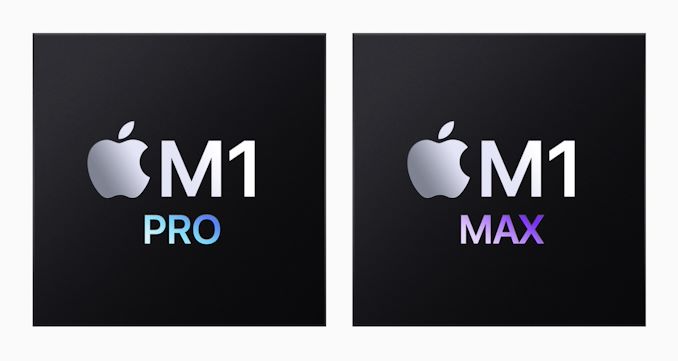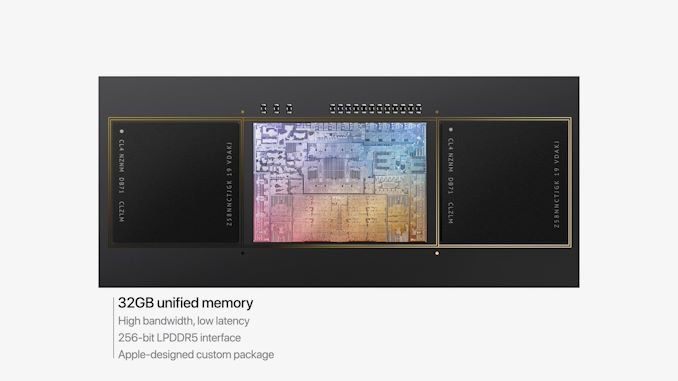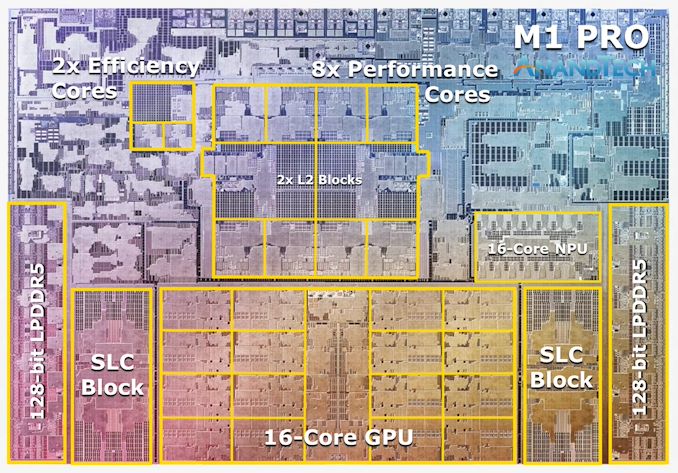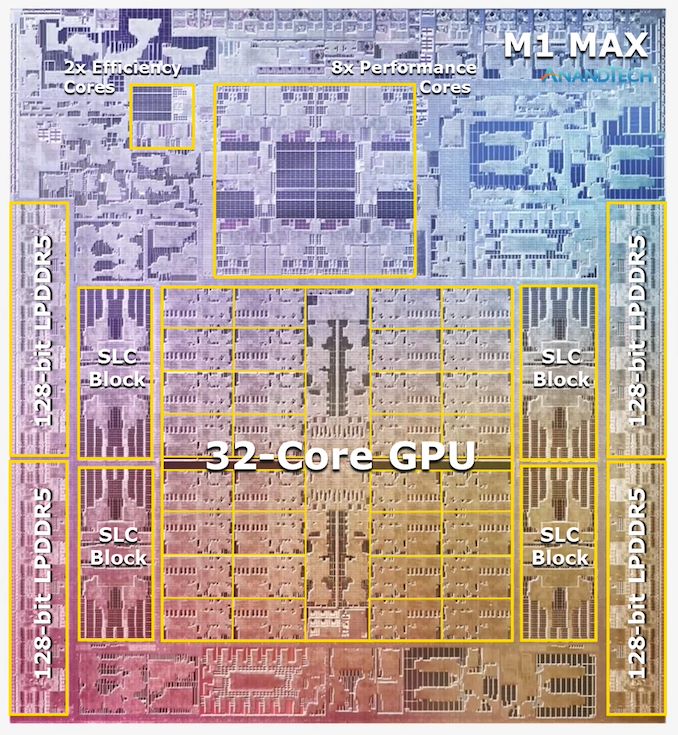Apple's M1 Pro, M1 Max SoCs Investigated: New Performance and Efficiency Heights
by Andrei Frumusanu on October 25, 2021 9:00 AM EST- Posted in
- Laptops
- Apple
- MacBook
- Apple M1 Pro
- Apple M1 Max

Last week, Apple had unveiled their new generation MacBook Pro laptop series, a new range of flagship devices that bring with them significant updates to the company’s professional and power-user oriented user-base. The new devices particularly differentiate themselves in that they’re now powered by two new additional entries in Apple’s own silicon line-up, the M1 Pro and the M1 Max. We’ve covered the initial reveal in last week’s overview article of the two new chips, and today we’re getting the first glimpses of the performance we’re expected to see off the new silicon.
The M1 Pro: 10-core CPU, 16-core GPU, 33.7bn Transistors
Starting off with the M1 Pro, the smaller sibling of the two, the design appears to be a new implementation of the first generation M1 chip, but this time designed from the ground up to scale up larger and to more performance. The M1 Pro in our view is the more interesting of the two designs, as it offers mostly everything that power users will deem generationally important in terms of upgrades.
At the heart of the SoC we find a new 10-core CPU setup, in a 8+2 configuration, with there being 8 performance Firestorm cores and 2 efficiency Icestorm cores. We had indicated in our initial coverage that it appears that Apple’s new M1 Pro and Max chips is using a similar, if not the same generation CPU IP as on the M1, rather than updating things to the newer generation cores that are being used in the A15. We seemingly can confirm this, as we’re seeing no apparent changes in the cores compared to what we’ve discovered on the M1 chips.
The CPU cores clock up to 3228MHz peak, however vary in frequency depending on how many cores are active within a cluster, clocking down to 3132 at 2, and 3036 MHz at 3 and 4 cores active. I say “per cluster”, because the 8 performance cores in the M1 Pro and M1 Max are indeed consisting of two 4-core clusters, both with their own 12MB L2 caches, and each being able to clock their CPUs independently from each other, so it’s actually possible to have four active cores in one cluster at 3036MHz and one active core in the other cluster running at 3.23GHz.
The two E-cores in the system clock at up to 2064MHz, and as opposed to the M1, there’s only two of them this time around, however, Apple still gives them their full 4MB of L2 cache, same as on the M1 and A-derivative chips.
One large feature of both chips is their much-increased memory bandwidth and interfaces – the M1 Pro features 256-bit LPDDR5 memory at 6400MT/s speeds, corresponding to 204GB/s bandwidth. This is significantly higher than the M1 at 68GB/s, and also generally higher than competitor laptop platforms which still rely on 128-bit interfaces.
We’ve been able to identify the “SLC”, or system level cache as we call it, to be falling in at 24MB for the M1 Pro, and 48MB on the M1 Max, a bit smaller than what we initially speculated, but makes sense given the SRAM die area – representing a 50% increase over the per-block SLC on the M1.
The M1 Max: A 32-Core GPU Monstrosity at 57bn Transistors
Above the M1 Pro we have Apple’s second new M1 chip, the M1 Max. The M1 Max is essentially identical to the M1 Pro in terms of architecture and in many of its functional blocks – but what sets the Max apart is that Apple has equipped it with much larger GPU and media encode/decode complexes. Overall, Apple has doubled the number of GPU cores and media blocks, giving the M1 Max virtually twice the GPU and media performance.
The GPU and memory interfaces of the chip are by far the most differentiated aspects of the chip, instead of a 16-core GPU, Apple doubles things up to a 32-core unit. On the M1 Max which we tested for today, the GPU is running at up to 1296MHz - quite fast for what we consider mobile IP, but still significantly slower than what we’ve seen from the conventional PC and console space where GPUs now can run up to around 2.5GHz.
Apple also doubles up on the memory interfaces, using a whopping 512-bit wide LPDDR5 memory subsystem – unheard of in an SoC and even rare amongst historical discrete GPU designs. This gives the chip a massive 408GB/s of bandwidth – how this bandwidth is accessible to the various IP blocks on the chip is one of the things we’ll be investigating today.
The memory controller caches are at 48MB in this chip, allowing for theoretically amplified memory bandwidth for various SoC blocks as well as reducing off-chip DRAM traffic, thus also reducing power and energy usage of the chip.
Apple’s die shot of the M1 Max was a bit weird initially in that we weren’t sure if it actually represents physical reality – especially on the bottom part of the chip we had noted that there appears to be a doubled up NPU – something Apple doesn’t officially disclose. A doubled up media engine makes sense as that’s part of the features of the chip, however until we can get a third-party die shot to confirm that this is indeed how the chip looks like, we’ll refrain from speculating further in this regard.














493 Comments
View All Comments
Ppietra - Thursday, October 28, 2021 - link
Gosh, no! not 2.35m people. You are so obsessed with a GPU having everything on silicon for itself that you fail to see how much more cache resources the SoC has when compared with other processors. Even if there was 1GB of cache you would still be complaining because the CPU can use it. Get some common sense.richardnpaul - Friday, October 29, 2021 - link
You're wrong. I've shown that your fringe is larger than some country's populations and you've dismissed it and pivoted back to another talking point, a point that is a misrepresentation of what I was saying.I was wondering what the effect was on performance of the CPU and GPU when both are being used and both are using the shared cache simultaneously given that we know that in isolation with just their own cache it improves efficiency. I'm not and haven't been saying it's an actual issue, it's something that could be tested, and also, we have no clue as to whether it's a real world problem or not.
The article was the one that was talking about the GPU and it having access to all the 512bit memory interface, I was challenging that saying that actually the CPU is going to use some of that bandwidth, but the benefit of the design is that when the GPU needs more and the CPU isn't using it it has access to it and vice-versa.
And if you knew anything about common sense you wouldn't say to get some of it. You're rude and dismissive of anyone else who doesn't fit into your world view, you might want to do something about fixing that about yourself; but probably you won't.
Ppietra - Friday, October 29, 2021 - link
No, you haven’t shown anything, because for whatever reason you continue to ignore how big the cache is when compared with anything else out there, and how big the L2 cache is, also when compared with anything else out there - something that they don’t share. Thirdly, if you even tried to pay attention to what was said, you would see that the M1 Max has double the system cache size, and yet not much different CPU performance.You also continue to ignore that in a game (which is the thing you are obsessing about), CPU and GPU work together. Not having to send instructions to an external GPU, and CPU and GPU being able to work on the same data stored in cache, gives a big performance improvement, it removes bottlenecks. So you obsessing because the CPU can use system cache during a game makes no sense, because the sharing can actually give a boost in game performance.
Fringe cases would never be equivalent to every gamer.
richardnpaul - Friday, October 29, 2021 - link
"continue to ignore how big the cache is when compared with anything else out there"Like the previously mentioned RX 6800 which has 256MB? I've not mentioned the RX6800 (infinity) cache at all?
The L2 cache is large, but then it doesn't have an L3 cache. This is a balancing act that chip architects engage with all the time. It seems that zen3 and the M1 Max graphs are very similar for latency with full random being a little higher but most everything else looking close enough that I'm not going to stick my neck out and declare either a winner.
"and CPU and GPU being able to work on the same data stored in cache, gives a big performance improvement, it removes bottlenecks"
This is not represented in the benchmarking, which might be because there needs to be some specific optimisation done, or it could be due to something else. I expect the situation to improve though, probable with more focus on the M1 Pro which will carry over to the Max.
Ppietra - Friday, October 29, 2021 - link
You are not going to see something in benchmark that is inherent to how the system works, how it manages memory, there is no off switch. You need to have the knowledge of how things work."The L2 cache is large, but then it doesn't have an L3 cache."????????????????
System cache behaves as if it was a L3 cache for the CPU. How can you say that zen 3 and M1 are similar when the M1 Max has 3.5 times the cache size of a laptop Ryzen??? Just the L2 cache is larger than all the cache available in a laptop Ryzen.
"RX 6800 which has 256MB?" A RX6800 isn’t a laptop chip. [" laptop processors " - - it’s there in one of the first comments]
richardnpaul - Saturday, October 30, 2021 - link
This is where you need to look at the latency graphs for M1 Pro/Max and then go and find the Zen 3 article and compare the graphs for yourself. And I haven't been comparing the M1 Max to a laptop Ryzen, I have repeatedly compared it to a single zen3 core complex where they are much closer in terms of total cache. Compare the 5nm M1 Max to the 7nm Zen3 all you like, with its much higher transistor count. You're not talking about the same thing as I was all along.I have repeatedly compared whatever is the closest comparison, regardless of where its used to get a helpful idea of what benefits it could bring. That Apple have managed to do this in a laptop's power budget is, and I'll quote myself here "a technological marvel". The M1 Pro/Max are combined GPUs and CPUs, that means you can compare them to standalone GPUs and to CPUs. You're the one who can't seem to understand that they both need to stand on their own merits.
Ppietra - Saturday, October 30, 2021 - link
Really!??? You want to compare a laptop processor with Desktop chips that can consume 3-4 times more than the all laptop, and you think that is close? no common sense whatsoever!But guess what even then a M1 Max has more cache available than a consumer desktop Ryzen!
The latency graphs are for the CPU (which, by the way you can actually see differences because of the size of the level 1 and 2 caches even with desktop Ryzen), they don’t tell you anything when you want to compare the response latency between CPU and GPU, nor about the performance boost from processing the CPU and GPU being able to process the same data in cache without having to access RAM.
Who said you cannot compare with dedicated GPUs?
richardnpaul - Sunday, October 31, 2021 - link
I'm comparing architectures, not products, that's why it seems to you like this is an "unfair" comparison. I also bear in mind what node the architecture is at, as that makes quite a marked difference due to transistor budget constraints.Yes M1 Max has more cache, and where you're not using the GPU (a bit difficult as you'll be running an OS which has a GUI, but let's say that that is basically negligible) it should have a reasonable impact on usages which are heavy on memory bandwidth. In fact you can see that in the benchmarks, there are a number of which heavily reward the M1 Max over anything else, not that many in total but certain use cases will see great uplifts, just the same as Milan-X and the equivalent chiplets in Ryzen CPUs which we'll get to see in the next few days will have benefits in certain use cases.
What I was saying way back was, what's the contention there, when running a game, how much benefit is the GPU getting and if any how much is the CPU losing when contention starts to happen on the SLC. Caches usually work on some kind of LRU basis, so if two separate things are trying to use the same cache (which can have benefits where they are both using the cache for the same data) both suffer as their older cache data is evicted by the other processor. That should be measurable. Workloads that share the same data, if its small enough to fit into the 48MB on the Max, should see huge benefits, and yes, one application that has been highlighted has taken advantage of this. But we are yet to see others take this up, AMD, having tried this before will tell you that if you can't get broad software support that it's a dead duck, however, Apple have often made long term bets and stuck with them over a number of years, which could make the difference.
Apple have approached this in two different ways. They have created a monster APU, AMD's effort was... safe, I think they thought that they could iterate over time to large better designs, however, no-one wanted to put that much time and effort into a bet that AMD would deliver in the future when Intel wasn't making similar noises.
They're on a cutting edge node, with a cutting edge design, and there's no other choice for Apple users, sure you can get the original M1 or M1 Pro, but there's no Intel to get in the way and the only downside of the other chips are that they will be slower due to having fewer resources but it's all much the same design.
OreoCookie - Wednesday, October 27, 2021 - link
No, the 24 MB = 2 x 12 MB are the shared L2 caches amongst the performance core clusters, the two efficiency cores share another 4 MB (so the M1 Pro and M1 Max have close to Zen 3 desktop-level L2 caches if you ignore the system level cache). These caches are not shared between CPUs and GPUs at all. Only the system-level cache of yet *another* 48 MB is shared amongst all logic that has access to main memory. Given that the total memory bandwidth is larger than what CPU and GPU need in a worst-case scenario, I fail to see how this is somehow an edge case.It seems the memory bandwidth so large that it can accommodate all CPU cores running a memory-intensive workload at full tilt *and* the GPU running a memory-intensive workload with room to spare. Even if you could saturate the memory bandwidth by also using the NPU (ML accelerator) and/or the hardware en/decoder, I think you are really reaching. This would be far beyond the capabilities of any comparable machine. Even much more powerful machines would struggle with such a workload.
richardnpaul - Thursday, October 28, 2021 - link
Yes sorry, I do know that, the 24 in 24/48MB was a reference to the M1 Pro which has half the shared buffer. That shared buffer, I'd need to go back and look at the access times (and compare it to Zen3 desktop) because it's almost on the other side of the chip from the cores.I do see that they tested a game at 4K, and I know that some games lean more heavily on the onboard RAM on dGPUs and not all games have specific high resolution 4K textures and so use more RAM than others. And it is mentioned on the second page that they didn't see anything that pushed the GPU over using 90GB/s of bandwidth and I don't know if that they were measuring during that testing run (I would expect that they were but you know what they say about assumptions :D).
I think that you're right and that the architecture team probably went overboard on the bandwidth anticipating certain edge case scenarios where the system has multiple tasks loading multiple parts of the CPU and we'll see some rebalancing in future designs. I would like to see a game run with or without mods that does stress the GPU memory subsystem (games aren't usually hammering the CPU bandwidth so more should be available to the GPU, which may very well never be able to saturate it by design, but the cache may be saturated). This will also tell us something about longevity of the SoC too.
I don't think that I'm reaching, more that I see systems lasting for 7+ years, and when newer generations of hardware move on unusual usage when some hardware is new suddenly becomes common place because newer hardware is a evolving target over time and sometimes software does actually utilise it. (Sometimes CPU bugs rob you of performance and make your hardware feel slow, other times it's just that software is a bit more demanding now than it was years before when you got it)